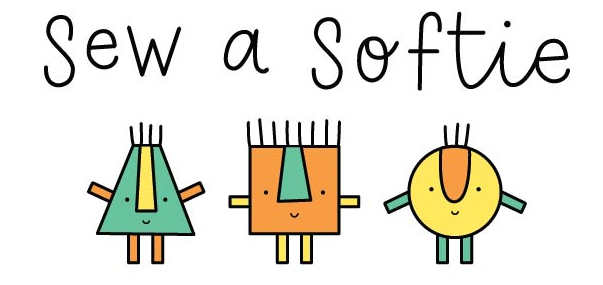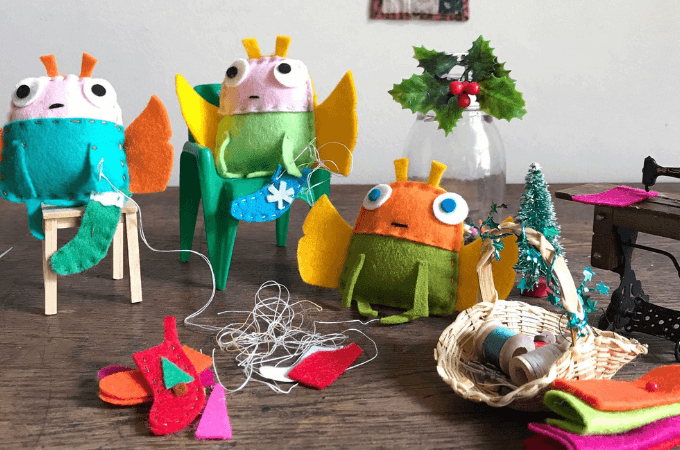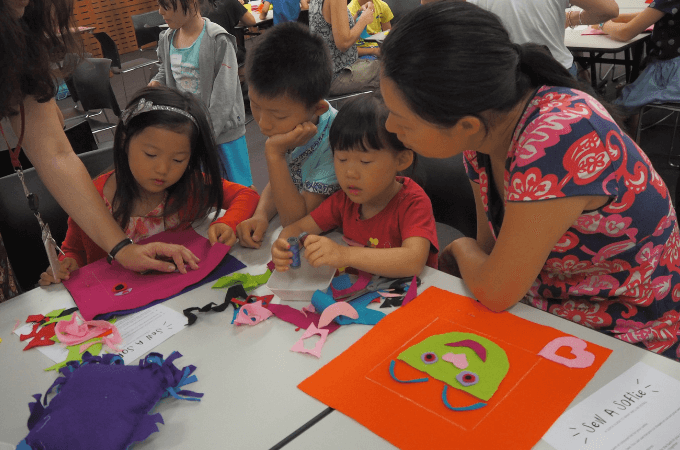Teaching sewing classes for kids: a how-to guide
I’m often contacted by mums who are thinking of teaching sewing classes to kids at home, at holiday camps, or teachers who want to start a lunch time or after school sewing club. Usually, they are looking for advice and some tips and tricks on how to run these kids sewing classes.
I should give a warning: kids sewing classes can be hectic, very hectic. My most important rule is “always be over prepared in every possible way”. Having said that, teaching kids to sew is also deeply rewarding and it’s lovely to see how proud kids are when they realise that they can really sew all by themselves.
The advice I give comes from over 20 years of experience in teaching kids to hand sew but it’s not the only way to run a workshop. It’s simply the way I like to run my workshops. I don’t teach sewing-machine skills. My workshops are, and have only ever been, focused on teaching kids to hand sew. There are several reasons I chose to focus on hand sewing. Firstly, I love hand sewing and only really use my sewing machine when I have to. Secondly, kids can continue their hand sewing at home and don’t need a to have a machine to use the skills they’ve learnt in class. And lastly, the materials required for hand sewing are readily available, low cost and highly portable.
Questions I’m asked about teaching sewing classes to kids or running a sewing club at school.
How many students should I have in my class?
Start small. It’s always a good strategy to start with a smaller number of students just to get an idea of how long it actually takes kids to sew a project and what difficulties kids might have when they’re sewing. So probably around 4 or 5 depending on the age of the students.
How long should the class be?
This obviously depends on the project you’re making. I’ve run classes from an hour and a half to all day classes running from 10am – 3pm. Make the class a bit longer than you think you need. There’s nothing more stressful than a group of parents waiting to pick up kids who are still happily sewing and trying to finish their work. I always have some projects that don’t require much assistance for fast workers. Also, I keep a box of left-over scraps that the kids can use to make their own creations from if they’ve completed their project.
What supplies do I need?
One of the great things about teaching hand sewing classes is that there’s a minimal outlay to get you started. You don’t need a lot of supplies and what you do need is pretty low cost. One thing I stress is to always buy good quality supplies. There is nothing more frustrating than sewing with a blunt needle and cutting with scissors that, well, don’t cut!
Another point I stress is that you should always give your materials a test run. That means, checking that the needle goes smoothly through your fabric and that the thread doesn’t break when you tug on it. And if you’re getting the kids to glue on any part of the project test that glue! Not all glues will work on felt even if they say fabric glue…I learnt that one the hard way.
Where do I begin?
Good question. Some people like to have an introductory lesson in which they teach the kids how to thread a needle, sew a running stitch and so on. That’s great if you’re doing a series of workshops or after school classes. My workshops tend to be stand alone single classes so I just dive straight into the sewing even if they’re first time sewers.
In their first lesson I let the kids get used to sewing and don’t worry them with being able to thread the needle all by themselves just yet. To this end, the project each student will be making is cut-out, pinned together and ready-to-sew when they walk in the door with a needle already threaded so they can focus on learning how to do a running stitch.
What age should I start from?
I start with kids as young as 5 years old and up but I’ve been teaching for 20+ years so I know what to expect. If you’ve never run a sewing workshop before, you might want to try starting from 8 years and up, just until you get an idea of the sorts of problems young kids have when they’re sewing. You’ll discover that knots can mysteriously appear in their thread, that they sometimes sew their project onto their clothing, that they can sew over the edge of their project, that they are sewing while chatting and and just forgetting to look at their work…there’s a whole raft of sometimes humorous and always picturesque problems that are unique to young sewers.
What should their first project be?
Start with something fairly simple just until the kids, and you, get your bearings. Again the duration of your workshop will determine your project but basically start with a project that has fairly straight lines, that is, avoid projects that involve too many curvy lines as they can be tricky for kids to sew around.
If you’re running a longer class, like an all day workshop you might like to start with a simple star cushion. It has straight but interesting lines. My version of the star cushion idea is to have a mother and baby star.
The kids love giving their star-mother a face and decorating her with ribbons and lace and decorative features. And if they finish early they can make a baby star cushion. Of course, once the fast workers begin to make baby-star, the rest want to make baby-star even if they don’t really have time. You get this frantic sewing happening five minutes before the mums are picking them up. And it’s amazing to see what kids can do when they’re really motivated.
What if one of the kids keeps sewing wonky stitches?
Another rule of mine: any stitch that a child sews is a good stitch. Wonky stitches are great, just as good really as perfectly neat and straight stitches. I never ever get kids to undo stitches. I simply keep showing them how to sew smaller stitches and how to keep on their sewing line. And yes, I always draw a sewing line for kids to sew on. So what happens if one of the kids sews around their project and the stitches are just so large that the stuffing comes out? Not a problem. The “every stitch is a good stitch” rule still holds. I just get the kids to sew over their large wonky stitches with a different coloured thread and that usually stops any stuffing from finding its way into the outside world.
What stitches should I teach?
The good old
running stitch has several things to recommend it. Firstly, it’s fairly easy to master and allows young sewers to be “up and running” without much fuss. Secondly, it’s a fairly quick stitch to sew. That’s a definite plus. Anything that helps young students to complete their project within a reasonable time is your friend. Thirdly, it’s very versatile. An awful lot of projects can be sewn with this stitch and it’s as good for decorative effects as it is at holding fabric together. Finally, it really is your basic stitch and the skills learnt with a running stitch make learning many other stitches much clearer. In my own classes, I let kids get used to this stitch so that they feel comfortable and natural with it.
Whats my favourite tool?
I
love my
white chinagraph pencil. It’s fantastic for drawing on felt or on dark fabrics where pencil lines just don’t show up. And its marks brush off very easily. I use my faithful chinagraph to mark out sewing lines for students. I’ve tried many different kinds of pencils from my sewing supply store and none of them worked well on felt except the chinagraph and none had much visibility on dark fabrics. I buy my white chinagraph from at the art supply store and it has made teaching kids to sew much easier.
One last piece of advice
I like to be really well prepared, so my one last piece of advice would be: always have threaded needles prepared and on-hand. In that last minute rush to get finished its great to be able to whip out those already-threaded needles and give them to the kids so they can finish their work.
A story
The other day a mum stopped to tell me that her daughter was going to her best friend’s wedding that very weekend. She wanted to remind me that the girls had met each other in my sewing workshops many years before and had stayed the closest of friends ever since.
That story summed-up for me the things I love most about teaching sewing to kids. The workshops are very social and relaxing. The girls sit in circles and chat as they work on their projects. They show each other their work and oftentimes, they will work together and design their projects together, they ‘copy’ each other but always in their own way…and I love that.
Those kids are working in a supportive non-competitive environment, an environment that’s usually very different to other learning contexts they’re used to, they make their own decisions and they are the ones who have to decide what their project should look like. And I love that in my all-day-workshops when it’s time for the kids to have a break and eat some morning tea or their lunch the most common question after 5 minutes is…can we go back inside and finish our sewing. That’s been my enduring experience as a sewing teacher to young kids and that’s what keeps me teaching kids sewing.
Don’t forget to join the Sew a Softie facebook group. If you’re looking for more tips and tricks on how to teach kids to sew you might like to look at my Pinterest board.
PIN IT








Do you usually start kids out with felt projects or do you use woven fabrics? I see that a lot of your projects are fairly big, so felt could be more costly. I haven’t tried teaching kids to hand sew but I love the idea! I like to make small items, but they might be harder for kids to hold onto when they are learning? My local library offers projects for chlidren and I’m friends with the lady who runs the program – I know if I volunteered to teach a class she would be thrilled!
I usually start on felt projects if I’m teaching a short workshop (one to one and a half hours).
Felt is easy and quick to work.
Projects are about 10-12 inches because this gives the kids time to practice their sewing skills as well some kids have difficulty sewing small, even stitches and a small project wouldn’t work.
Felt should be fairly inexpensive. You can use acrylic but please pretest to see how easy it is to sew or wool blend felt is another great alternative.Pure wool felt is expensive!
Libraries all around the world have joined into Sew a Softie and the Global kids sewing party in February to sew softies. The most common project they’ve made is my ZENKI tutorial.
Please let me know if you need any more help.
If you do use Zenki for any of you’re workshops I would appreciate a link back to Sew a Softie and Coloured Buttons to help spread the Sew a Softie message that kids love to sew!!
Hello,
Wondering if you can share the exact name and brand of the chinagraph pencil you use? I too have tried a lot of the fabric marking pencils from sewing supply stores, with no luck on dark fabric.
Thankyou! Love your ideas.
Hello. I live in Iran. I am a primary school teacher. I have sewing and embroidery workshops for children 3 years and older. I have a 5-year-old girl who has been embroidering with me for 2 and a half years. I enjoyed your site very much. Like you, I’m really amazed at being with the kids and sewing and sewing and sewing
I love that you are teaching such young kids to sew!! It is amazing to see how much kids love sewing and how good they are at sewing. Please join our Global Kids Sewing party in March if you can!!!